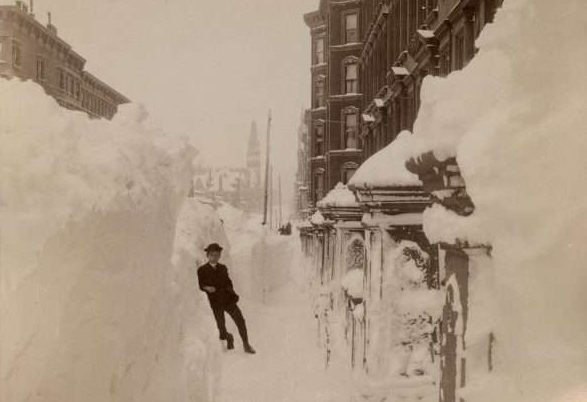 This photograph of an unidentified boy shows the enormous drifts of snow deposited in the streets of New York City by the blizzard of March 11-14, 1888.
This photograph of an unidentified boy shows the enormous drifts of snow deposited in the streets of New York City by the blizzard of March 11-14, 1888.
The storm stretched from the Chesapeake Bay to Canada and left devastation in its wake, disrupting rail, telegraph, and mail service and causing hundreds of deaths and tens millions of dollars in property damage.
An Unexpected Storm
In a year in which a winter storm known as the “Schoolhouse” or “Children’s Blizzard” had already claimed the lives of 235 people and thousands of cattle and other livestock in the Plains States, perhaps the residents of the Eastern Seaboard could have been forgiven for thinking that winter was over when March dawned temperate, with crocuses already emerging.
That belief was soon to be shaken by a winter storm against which all subsequent storms would be measured.
The “Great White Blizzard,” as it is sometimes called, began on March 11, 1888 and raged for 72 hours.
Snow drifts averaged 30 to 40 feet, over the tops of houses from New York to New England, with reports of drifts covering three-story houses. The highest drift was recorded in Gravesend, Brooklyn at 52 feet.
Fifty-eight inches of snow fell in Saratoga Springs; 48 inches in Albany; 45 inches in New Haven, Connecticut; and 22 inches in New York City.
The storm also produced severe winds; 80 miles per hour wind gusts were reported, although the highest official report in New York City was 40 miles per hour, with a 54 miles per hour gust reported at Block Island.
On March 13, New York City recorded a low of 6 degrees Fahrenheit, the coldest so late in the season, with the high rising to only 12 degrees.
Temperatures were in the single digits and the wind gusted to 80 miles per hour. Thanks to this driving wind, snow drifted as high as 30 to 40 feet.
First Hand Accounts
The weather was a source of almost universal comment for diarists of the time.
The Massachusetts Historical Society’s collection includes hundreds of diaries kept by individuals from all walks of life, including four that give an interesting picture of this storm from different locales.
Reverend Andrew Oliver found himself in the path of the storm in Springfield, Otsego County, New York. His entry for March 12th reads, “Blizzard!! A great snow storm & furious wind all day. Snow very deep & drifting badly. No street cars running.” The next day he records, “Still very cold & windy. Mercury 7 abv. 0 at 7 … snow out front piled up i[n] t[he]street to a depth of 5 or 6 feet. No cars running & no trains in or out of t[he] city. Take a short walk. The streets present an extraordinary spectacle.”
Lyman Worden, a farmhand in Barre Plains, Massachusetts, had a much less romanticized view of all that snow, writing on the 14th and 15th, “14. Shovel snow ½ day. Snow sticks to shovel and acts mean. Some big drifts 6 or 7 ft. deep. 15. Shovel snow. Road broke from Hamilton’s to town. No pay for shoveling.”
In Dorchester, Massachusetts, where snow and rain had mixed, keeping the snowfall totals low, Henry Pierce recorded the news that “The storm of yesterday was very severe Heavy snows & R Roads blocked Telegraph wire down Said to have been the worst for eons.”
Thomas Bradford Drew of Plymouth, Massachusetts, where the storm was merely a cold rain, recorded interesting stories despite being the least affected. On the 14th, he wrote, “A terrible snow storm raged in New York and Western Massachusetts day before yesterday, while we were having not much more than a cold rain storm. No communication has been recd, from New York City to Boston excepting by Atlantic Cable by way of London England!!!” He goes on to record the misadventures in travel of two acquaintances:
“Lillie Briggs and Rita Smith started from Boston for Florida on Monday the 12th by Boston & Albany RR and the cars were stuck in the snow about six miles this side of Springfield and there they had to remain two whole nights and did not reach that city until this P.M. It was a hard experience for them. … Saturday 17th We had a letter from Lillie and Rita who are now in Springfield waiting to go to New York when the time comes to be sure of getting there. They said the nights on the snow bound train they were in were horrible.”
Communities “Cut Off”
Cities and towns up and down the East Coast were “cut off,” as the headline in the March 13th issue of the Boston Globe reported.
The storm knocked out telegraphic and postal communications and trains could not get through the drifts. Travel, even short distances, was nearly impossible until brigades of snow shovelers and horse-drawn snow rollers had cleared the streets.
Supplies of food ran short as trains sat at a standstill for a week or more. The storm did lead to many infrastructure improvements, including the burying of overhead utility lines in major cities and the creation of America’s first subway in Boston, Massachusetts, which opened nine years later.
The blizzard caused more than $20 million in property damage in New York City alone and killed more than 400 people, including about 100 sailors, across the Eastern Seaboard.
The storm led to many infrastructure improvements, including the burying of overhead utility lines in major cities and the creation of America’s first subway in Boston, which opened nine years later.
Illustration: Detail from a photo taken at Madison Avenue and 40th Street, New York City, during the Great Blizzard of March 1888. You can view the photograph, which is held by the Massachusetts Historical Society, up close here.


